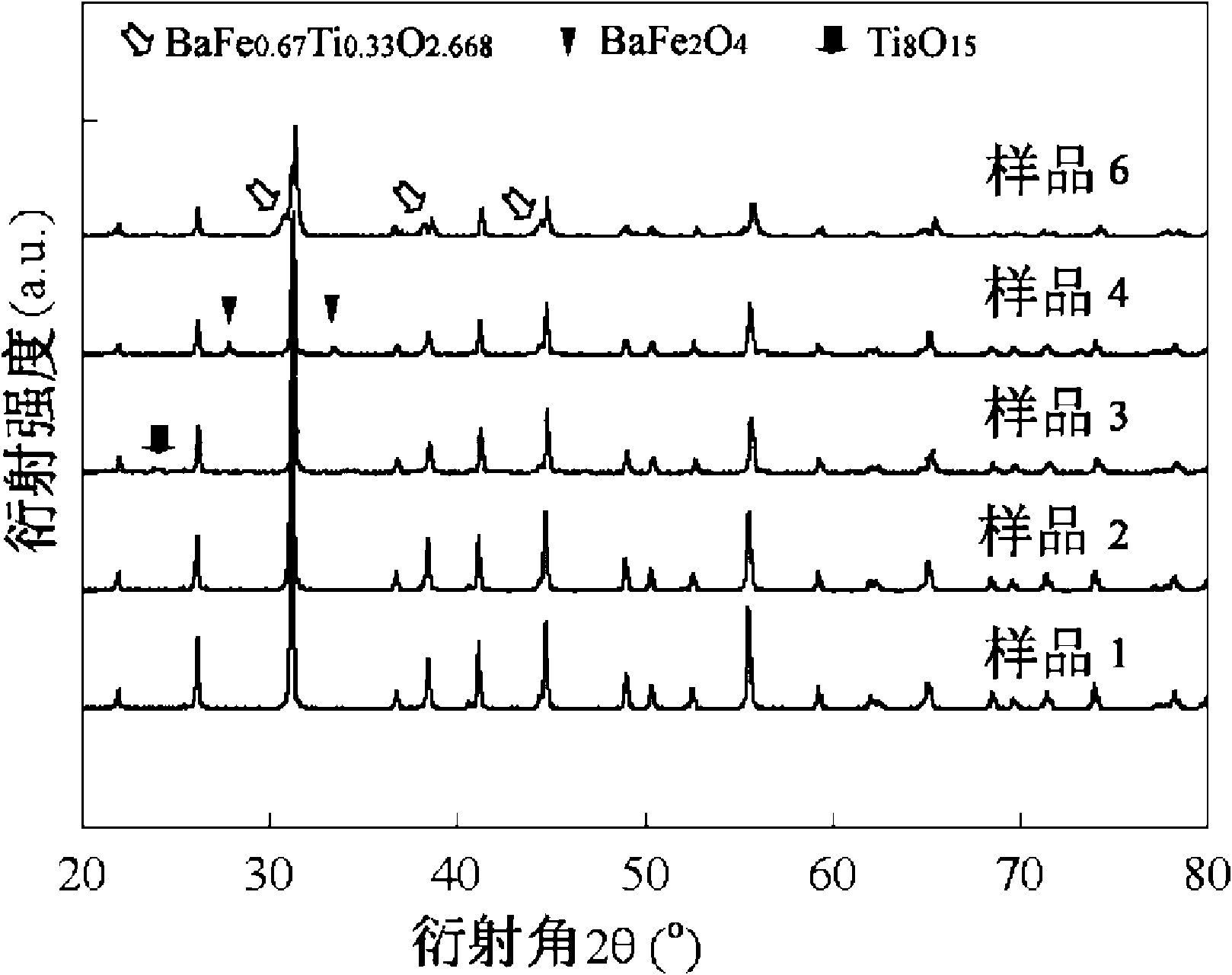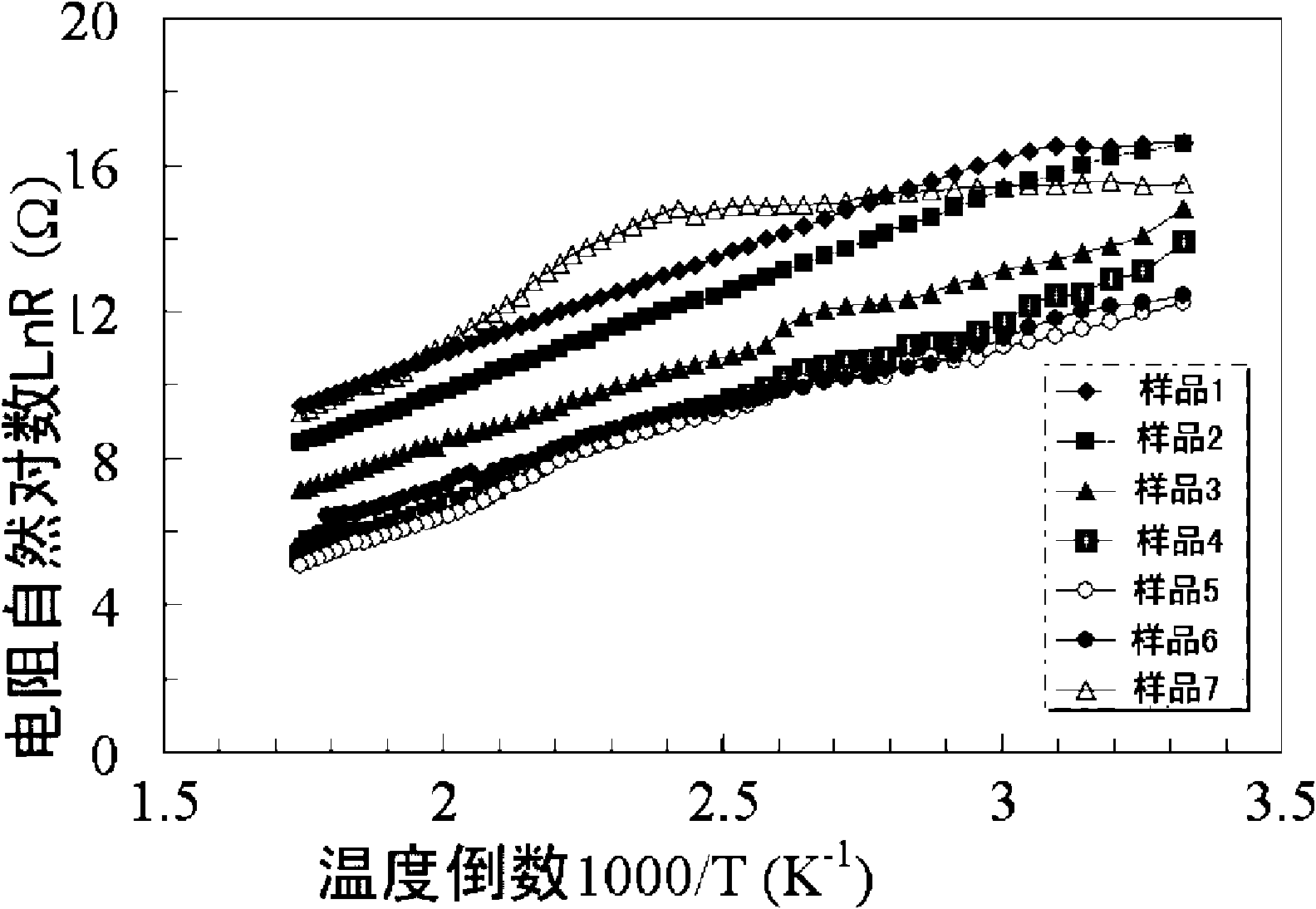Thermal sensitive ceramic resistance material, resistance element and preparation method of resistance element
A technology of heat-sensitive ceramics and resistance materials, applied in the direction of resistors with negative temperature coefficient, etc., can solve the problems affecting the performance and service life of materials, unstable electrical properties, material aging, etc., to achieve good product composition consistency, It is beneficial to mass production and improves the stability of material properties
- Summary
- Abstract
- Description
- Claims
- Application Information
AI Technical Summary
Problems solved by technology
Method used
Image
Examples
Embodiment 1
[0031] This example according to molecular formula BaTi 1-x Fe x o 3 Dosing, x=0.1. The initial raw material is selected from barium carbonate (BaCO 3 ), tetra-n-butyl titanate ([CH 3 (CH 2 ) 3 O] 4 Ti), ferric oxide (Fe 2 o 3 ). Materials were prepared according to the following experimental process steps:
[0032] Press the initial raw material as BaTi 0.9 Fe 0.1 o 3 Formula ingredients, weigh 77.71g BaCO 3 , 119.74g[CH 3 (CH 2 ) 3 O] 4 Ti, 3.15g Fe 2 o 3 .
[0033] The raw materials weighed in the previous step were dissolved in 6mol / L dilute nitric acid respectively.
[0034] Mix the three solutions prepared in the previous step together, stir and mix evenly with a magnetic stirring heater, and heat and dry.
[0035] The powder obtained in the previous step is calcined at a temperature of 1000°C and kept for 2 hours.
[0036] The powder synthesized in the previous step is granulated and pressed into a green body; the green body is in the shape of a d...
Embodiment 2
[0043] This example according to molecular formula BaTi 1-x Fe x o 3 Dosing x = 0.2. The initial raw material is selected from BaCO 3 、[CH 3 (CH 2 ) 3 O] 4 Ti, Fe 2 o 3 . Materials were prepared according to the following experimental process steps:
[0044] ① Press the initial raw material to BaTi 0.8 Fe 0.2 o 3 Formula ingredients, weigh 81.13g BaCO 3 , 112.14g[CH 3 (CH 2 ) 3 O] 4 Ti, 6.64g Fe 2 o 3 .
[0045] ②The preparation process is the same as the steps ②~⑨ in Example 1.
[0046] X-ray diffraction analysis of the as-prepared material figure 1 In sample 2, the material performance test results are shown in Table 1 and figure 2 shown.
Embodiment 3
[0048] This example according to molecular formula BaTi 1-x Fe x o 3 Dosing, x=0.3. The initial raw material is selected from BaCO 3 、[CH 3 (CH 2 ) 3 O] 4 Ti, Fe 2 o 3 . Materials were prepared according to the following experimental process steps:
[0049] ① Press the initial raw material to BaTi 0.7 Fe 0.3 o 3 Formula ingredients, weigh 85.89g BaCO 3 , 103.69g[CH 3 (CH 2 ) 3 O] 4 Ti, 10.53g Fe 2 o 3 .
[0050] ②The preparation process is the same as the steps ②~⑨ in Example 1.
[0051] X-ray diffraction analysis of the as-prepared material figure 1 In sample 3, the material performance test results are shown in Table 1 and figure 2 shown.
PUM
| Property | Measurement | Unit |
|---|---|---|
| Diameter | aaaaa | aaaaa |
| Thickness | aaaaa | aaaaa |
Abstract
Description
Claims
Application Information
 Login to View More
Login to View More - R&D
- Intellectual Property
- Life Sciences
- Materials
- Tech Scout
- Unparalleled Data Quality
- Higher Quality Content
- 60% Fewer Hallucinations
Browse by: Latest US Patents, China's latest patents, Technical Efficacy Thesaurus, Application Domain, Technology Topic, Popular Technical Reports.
© 2025 PatSnap. All rights reserved.Legal|Privacy policy|Modern Slavery Act Transparency Statement|Sitemap|About US| Contact US: help@patsnap.com


